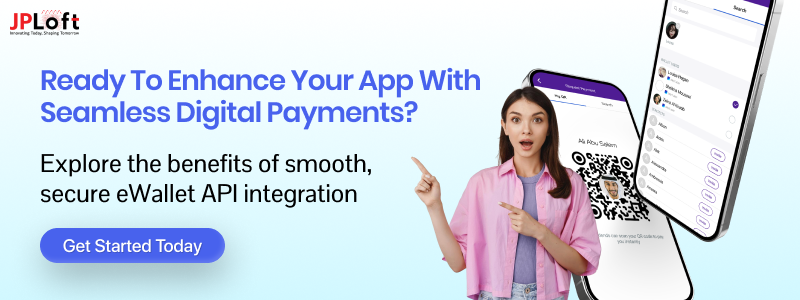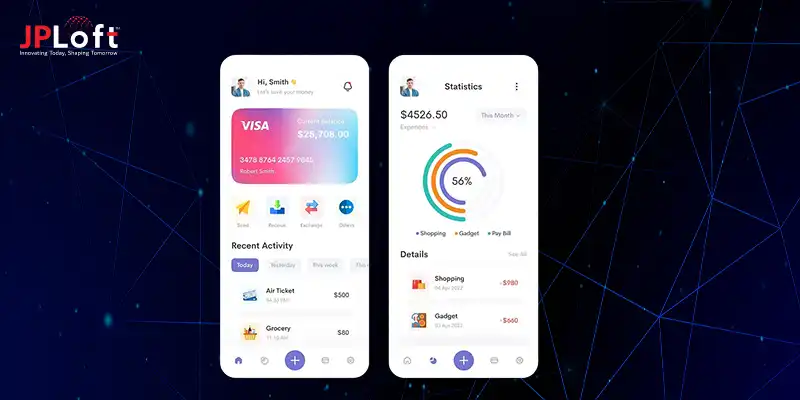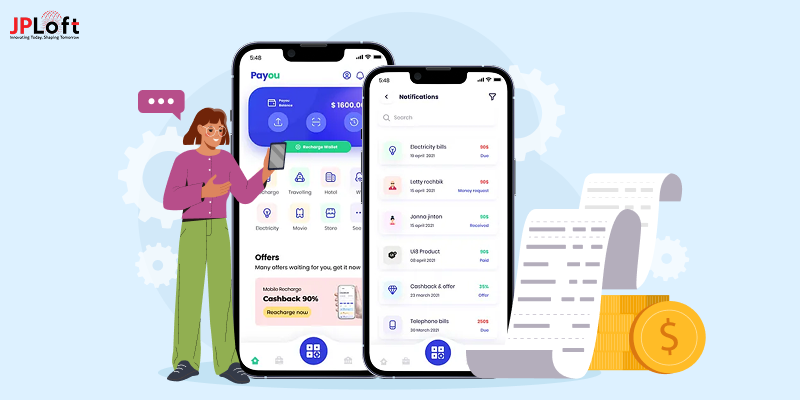Looking to supercharge your app with seamless payments? Say hello to eWallet APIs Integration, the magic behind effortless, secure digital wallets!
No matter if you’re creating a shopping app, a game, or something totally different, adding eWallet APIs lets your users pay, send, and receive money quickly and easily. But here’s the catch: not every API is built the same.
Wondering how to choose the right API? Choosing the right API means finding a solution that combines ease of use, security, and reliable performance.
In this guide, we’ll break down the must-knows and fun tips to help you pick the API that fits your project perfectly.
Ready to make your app’s payment experience smooth, speedy, and secure? Let’s dive into the world of eWallet APIs integration and get you set up for success!
What is the eWallet API?
An eWallet API is the tech that powers digital payments in your app. It acts as a secure bridge between your app and a payment system.
With eWallet API integration, users can store money, make payments, and transfer funds effortlessly.
It also allows them to view their transaction history all in one place.
Integrating an eWallet API makes the payment experience smooth, fast, and secure.
Whether it’s an eCommerce app, a gaming platform, or a ride-booking service, this API fits right in.
Popular services like Apple Pay, Google Pay, and custom wallets all use this tech. Security is built in, so your users’ data stays protected.
No cash, no hassle, just seamless digital transactions. In today’s digital world, an eWallet API isn’t a nice-to-have. It’s a must.
How do eWallet APIs Work?
eWallet APIs are the behind-the-scenes engine that powers every digital transaction.
They act as the link between the app, the payment system, and the financial institution, ensuring money moves quickly, securely, and reliably.
Here’s a breakdown of how they function, step-by-step:
► Initiation
The process begins when a user initiates a transaction by clicking a “Pay” button, scanning a QR code, or selecting a service to purchase.
This action sends a request to the eWallet API, signalling that a new payment process needs to begin. It’s the API’s cue to start coordinating the next steps of the transaction.
► Authentication
Once the request is made, the eWallet API immediately triggers an authentication process.
This could include biometric scans (like face ID or fingerprint), a secure PIN, or a one-time password (OTP).
This step ensures the user is authorized to complete the transaction, adding a strong layer of security and trust to the process.
► Payment Method Selection
Next, the API pulls up available payment sources linked to the eWallet, such as a saved debit card, credit card, bank account, or wallet balance.
The user selects their preferred method, and the API prepares the transaction based on that choice.
This flexibility helps enhance the overall user experience by providing a tailored payment flow.
► Transaction Processing
This is where the core of the payment takes place.
Once the method is selected, the eWallet API communicates with payment gateways, banks, or other financial partners to process the transaction.
It checks for available balance, validates the payment path, and securely transfers the funds all in a matter of seconds.
► Confirmation and Notification
After the transaction is completed, the eWallet API sends a confirmation message to the user’s app interface.
It also triggers push notifications, updates transaction logs, and synchronizes the payment status with the backend.
This final step ensures the user is informed and the system is fully up to date.
This entire flow happens almost instantly, and that’s the real beauty of eWallet API integration.
It simplifies complex operations, enhances security, and delivers seamless digital payment experiences.
Why eWallet API Really Important?
Digital payments are no longer a luxury, they’re an everyday necessity.
Whether it’s splitting a bill, shopping online, or sending money to a friend, people expect fast, secure, and convenient options. That’s where the eWallet API plays a vital role.
It acts as a bridge between your app and digital wallet systems, making payments smooth and real-time.
For any business building a modern financial product, eWallet API integration isn’t just useful — it’s essential.
Let’s break down why it matters so much:
1. Effortless Integration for Developers
With eWallet APIs, developers can plug payment features directly into their apps.
No need to build a payment system from scratch — the API handles all the heavy lifting.
This makes eWallet API integration a go-to solution for startups and businesses wanting to launch quickly and efficiently.
2. Fast and Reliable Transactions
A major benefit of using an API is speed.
Users can send, receive, or request money in real time, without any delays.
This kind of smooth experience is what API-powered digital wallet solutions are designed to deliver.
3. Bank-Level Security Built In
Security is baked into the system.
An eWallet API uses secure protocols, encryption, and authentication to protect user data and funds. So, it has its own importance in mobile banking app development.
It helps businesses offer a trusted environment that users feel safe in, without having to build complex security systems from scratch.
4. Cleaner, Simpler User Experience
A well-integrated API means users don’t have to switch apps or open new pages to make a payment.
Everything happens in-app: fast, clear, and intuitive.
That’s the beauty of an API-powered eWallet app: it keeps things seamless for the end user.
5. Multiple Payment Options in One Place
Most digital wallet APIs support a wide range of payment methods — from credit cards and bank accounts to QR codes and mobile transfers.
This flexibility gives users more freedom to pay how they want, boosting satisfaction and engagement.
6. Ready to Scale as You Grow
As your user base grows, your payment system needs to grow with it.
A strong eWallet API integration handles thousands, even millions, of transactions smoothly.
It’s built to scale, ensuring consistent performance even during high traffic or peak business hours.
7. Lower Costs, Faster Launches
Using a ready-to-go API-powered digital wallet solution is far more cost-effective than building a payment system from the ground up.
You save money on development, avoid costly security pitfalls, and reach the market faster — all while offering a premium payment experience.
Key Components of eWallet API
An API-powered eWallet app isn’t just a single feature, it’s built on multiple, well-defined modules that handle different parts of the digital payment process.
These components of the eWallet API come together to deliver fast, secure, and user-friendly experiences.
For anyone considering eWallet API integration, here’s a breakdown of the essential building blocks:
1] User Authentication & Authorization
This is the first line of defence. It manages how users log in and gain access to their wallets securely and reliably.
A strong API integration for the eWallet app starts here, ensuring identity verification is smooth but effective.
What it handles:
-
- Log in via password, OTP, PIN, biometrics, or magic link
- OAuth or token-based sessions for secure access
- Multi-factor authentication (MFA) for added protection
2] Account Management
This component acts as the user’s personal dashboard. It allows them to customize their profile and control how their money flows in and out of the wallet.
In any eWallet API integration, this is what gives users real control over their financial activity.
What it handles:
-
- Adding/editing user profile information
- Linking bank accounts or cards
- Managing wallets for multiple currencies
- Setting transaction limits or preferences
3] Balance Management
A critical part of the wallet system, this ensures that the user's balance is always accurate and up to date.
Every API-powered eWallet app depends on this component to deliver real-time balance tracking and prevent errors.
What it handles:
-
- Updating wallet balance in real-time
- Ledger tracking for each transaction
- Error handling during failed or reversed transactions
- Support for multiple balance types (main, bonus, locked funds, etc.)
4] Transaction Processing
This is the core engine that moves money, Rwhether it’s between users or to a merchant. It handles the flow of funds securely and efficiently.
No eWallet API integration can succeed without reliable and high-speed transaction processing.
What it handles:
-
- Peer-to-peer (P2P) payments
- Merchant transactions
- Refunds and reversals
- Transaction status updates (pending, success, failed)
5] KYC & Compliance
This ensures your app follows regulations. Every country has its own financial rules, and this component helps your wallet stay compliant.
This part of the components of the eWallet API is essential for building trust and staying legally protected.
What it handles:
-
- Collecting ID documents
- Verifying user identity (manually or automatically)
- Performing risk assessments
- Ensuring AML (Anti-Money Laundering) compliance
6] Security & Fraud Detection
Security measures are crucial for protecting financial transactions.
Keeping user funds and data safe is non-negotiable. This component actively monitors suspicious behaviour and stops fr
And, before it happens.
A well-implemented API integration for the eWallet app should always include real-time fraud prevention tools.
What it handles:
-
- Device fingerprinting
- Unusual behavior detection (like logging in from a new location)
- Blocking suspicious transactions
- Rate-limiting and anti-bot measures
7] Notifications & Alerts
Transparency is key for user trust. This component sends timely alerts about account activity, helping users stay informed and in control.
In any API-powered eWallet app, this feature builds confidence and engagement.
What it handles:
-
- Transaction confirmations
- Failed login attempts
- Low balance warnings
- Promotional offers or rewards
8] Analytics & Reporting
Data is power - especially for fintech products. This component provides insights to users and businesses, helping them track usage and spending behaviour.
It’s a core part of scaling your eWallet API integration with data-driven decisions.
What it handles:
-
- Spending breakdown by category
- Monthly transaction summaries
- User engagement reports
- Wallet performance metrics
9] Integration Layer
This component connects the wallet to other systems: payment gateways, banks, loyalty programs, and even crypto tools.
Without this, an API integration for eWallet app wouldn’t be possible — it’s what makes the entire ecosystem work together.
What it handles:
-
- Payment gateway integration
- Connecting with banking partners
- Plug-ins for loyalty, rewards, or crypto
- Webhooks and callbacks
What Is the Role of an eWallet API?
One of the questions that often sticks in mind, ‘what is the role of eWallet APIs in modern payment?” So, let’s find out what some of the common roles of an eWallet API are:
A] Lightning-Fast Checkout
Nobody likes waiting, right? eWallet APIs speed up your checkout process by allowing users to pay instantly without entering card details every time.
They integrate smoothly with your app or website, allowing quick taps, scans or clicks to complete payments.
This reduces cart abandonment and keeps customers happy-because a faster checkout means more sales and also less frustration for your users.
B] Ironclad Security You Can Trust
Worried about online fraud?
With cyber threats growing, eWallet API integration helps safeguard every transaction through encryption, tokenization, and fraud detection.
These protect your users' sensitive data and give them peace of mind while paying.
For you, this means fewer chargebacks and a trustworthy reputation. When payments are safe, your customers keep coming back without hesitation.
C] Global Payments without Brokers
Expanding your business overseas? eWallet APIs support different currencies and international payment methods, so you can sell anywhere without headaches.
Your customers can pay in their local currency, making transactions feel native and simple.
Combine that with the feature of the eWallet app, and you’re not just processing payments- you’re enabling personalized, location-based payment experiences.
This global reach opens new markets and boosts revenue without needing a complicated financial setup.
D] Mobile-First, Always Ready
We all live on our phones nowadays. eWallet APIs are designed to seamlessly integrate with mobile apps and wallets, giving your customers smooth tap-and-go payment experiences.
Whether on iOS or Android, your users can pay anytime and anywhere with zero hassle- perfect for businesses focused on mobility and convenience.
E] Quick Payment Insights
Want to keep track of every transaction in real time? eWallet API integration is your go-to option.
These APIs provide detailed dashboards & quick notifications about payments, refunds, and transfers.
This transparency lets you monitor cash flow, detect issues early, and improve financial planning.
For customers, it means up-to-date info on their balances and payments- no surprises, just confidence.
One of the challenges of eWallet app development is real-time syncing- eWallet APIs handle that like a pro.
F] Flexible and Scalable to Your Needs
Your business is unique, and your payment systems should be too.
eWallet APIs can be easily customized, letting you add features like loyalty rewards, instalment plans, or instant refunds.
Plus, they scale effortlessly as your business grows, handling increasing users and transactions without a hitch.
This flexibility means your payment system grows with you, not against you.
With this being said, let’s talk about some of the best eWallet APIs you should know about.
What are Some of the Best eWallet API?
Choosing the right eWallet API can make or break your payment experience.
The best APIs bring features like top-tier security, real-time processing, multi-currency support, and seamless scalability.
But no two businesses are the same, so selecting the right solution depends on your platform, your audience, and the payment experience you want to deliver.
If you're building from the ground up or preparing to scale, investing in smart, efficient eWallet API integration is key.
It’s a great idea to hire dedicated developers who can implement these APIs effectively and tailor them to your business goals.
Here’s a quick look at some of the best eWallet APIs available today:
|
eWallet API |
Key Features |
Best For |
Pricing |
|
PayPal API |
Widely trusted, global reach, recurring payments, and fraud protection |
Global businesses, eCommerce apps |
Transaction-based fees |
|
Stripe Issuing + Wallets |
Virtual cards, wallet integrations, flexible API, developer-friendly |
Fintech startups, subscription models |
Pay-as-you-go pricing |
|
Google Pay API |
Easy Android integration, tokenized payments, biometric security |
Android apps, contactless payment flows |
Free (Google takes no fees) |
|
Apple Pay API |
Seamless iOS support, high security, Face ID support |
iOS apps, Apple ecosystem users |
Free (merchant bank fees apply) |
|
Razorpay Wallet API |
India-specific wallets (Paytm, PhonePe), quick integration, UPI support |
Indian market, SMEs, mobile-first apps |
Transaction fee per payment |
|
Cashfree API |
Quick payouts, wallet balance management, India-focused features |
Indian startups, gig economy platforms |
Competitive pricing tiers |
|
Braintree API |
From PayPal, supports wallets like Venmo, Apple Pay, Google Pay |
Multi-wallet integration, marketplaces |
Custom pricing |
These APIs each bring unique advantages.
Whether you need biometric security, regional wallet support, or subscription billing features, integrating the right eWallet API will future-proof your payment experience.
How to Pick the Right eWallet API for Your Project?
A smart reader might ask after exploring all the details: “But how do I choose the right eWallet API for my project?”
The answer? It’s not just about choosing the most popular one, it’s about picking a solution that fits your app’s users, market, and business goals.
Whether you're exploring fintech app development services or scaling an existing platform, the right API integration in eWallet development is a game-changer. Let’s break it down step-by-step.
1. User Base and Geographic Focus
Before jumping into API specs, take a good look at who you're building for and where they are.
Your users’ devices and locations directly impact which API-enabled eWallet apps will perform best.
-
- iOS Focus: If a large chunk of your audience is using iPhones, especially in markets like the U.S., UK, or Australia, Apple Pay should be a top contender. It integrates natively with iOS, supports biometric security, and offers a frictionless payment experience.
- Android Audience: Catering to Android users? Google Wallet is essential. It's widely supported across Android devices, offers smart authentication tools, and is perfect for mobile-first payment flows.
- Global Reach: If your user base spans multiple regions, go with APIs that handle multi-currency support, real-time currency conversion, and local payment preferences.
Think PayPal, Stripe, or Razorpay, depending on the region. This is where a global API-powered digital wallet solution shines.
2. Key Features to Prioritize
Choosing an eWallet API isn’t just about payments, it’s about delivering trust, flexibility, and growth-ready infrastructure. Here’s what to evaluate:
-
- Security: Look for advanced protection features like PCI-DSS compliance, end-to-end encryption, and tokenization. The safety of sensitive user data must be a top priority in any API-enabled eWallet app.
- Ease of Integration: A good API should come with clean, well-documented SDKs, test environments, and responsive developer support. The smoother the integration process, the faster you go to market.
- Payment Options: The more the merrier, credit cards, debit cards, UPI, QR-based transfers, and in-app wallet recharges should all be on the table. A robust API-powered digital wallet solution supports various transaction methods tailored to user habits.
- Notifications: Integrating real-time notifications via SMS or email (using APIs like Twilio or SendGrid) is a great way to keep users updated on payments, transfers, or account activities.
- Analytics & Behavior Tracking: Use tools like Mixpanel or Google Analytics APIs to track user engagement, identify drop-off points, and continuously improve your wallet experience.
- Compliance Ready: Make sure the API adheres to global and local regulations – GDPR, RBI guidelines (for India), PSD2 (for Europe), etc. Being compliant avoids legal risks down the line.
3. API Selection Strategy
Not all APIs serve the same purpose. Here’s how to mix and match based on your app’s goals:
-
- Payment Processors: Go with Stripe, PayPal, or Braintree, if you're looking for global reach, modern interfaces, and smooth API integration in eWallet environments. They offer pre-built components and customizable modules.
- Specialized APIs: Need advanced features? Use tools like Currency Layer for live exchange rates, Twilio for messaging and OTPs, & Google Analytics for user insights
- Blockchain APIs: If you’re tapping into DeFi or building a crypto-enabled wallet, consider APIs like Coinbase Commerce or BitPay for cryptocurrency transactions. These can elevate your product into a future-ready solution.
4. Testing and Support
Don’t launch without testing, and don’t choose an API provider without strong support.
-
- Thorough Testing: Simulate real-life scenarios: failed payments, low network connectivity, device switching, etc. A good API should handle these smoothly without breaking the user flow.
- Reliable Support: Pick an API with a reputation for solid uptime, quick bug fixes, and responsive developer support. Look for active forums, chat support, and knowledge bases.
5. Design Considerations
Finally, your eWallet should not only function well, it should look and feel intuitive.
-
- User Interface (UI) & User Experience (UX): Prioritize simple layouts, fast-loading screens, and a visual experience that builds trust. Users should instantly understand how to top up, send money, or check their balance.
- Native vs. Hybrid Apps: Native apps usually offer smoother performance and deeper integration (especially when using Apple Pay or Google Wallet). But if you need faster deployment across platforms, hybrid apps work too—just ensure the eWallet API supports your chosen stack.
- Closed vs. Open Wallet Systems: Are you building a closed wallet (usable only within your ecosystem, like Starbucks or Ola) or an open system (usable with virtual cards or across merchants)? Your API choice must support this architecture from day one.
Choosing the right eWallet API isn’t just a technical decision, it’s a strategic one. It’s about ensuring your app meets user expectations, market needs, and long-term scalability.
How JPLoft Can Help You Develop a Custom API?
Need an API that does more than just “work”? JPLoft delivers exactly that.
As a top-tier eWallet app development company, we specialize in building custom APIs that power seamless, secure, and scalable digital payment experiences.
Whether you're launching a new wallet app or expanding your fintech platform, our developers design robust backend systems tailored to your exact business needs.
From transaction automation to third-party integrations, we ensure every API component aligns with your product vision.
Our solutions are built for performance, tested for reliability, and optimized for growth.
JPLoft turns complex payment logic into user-friendly experiences, faster, safer, and smarter. Let us build the digital bridge your product truly deserves.
Conclusion
Digital wallets are no longer the future, they’re the present.
With eWallet API integration, your app can offer lightning-fast, ultra-secure, and hassle-free payments, keeping users engaged and transactions smooth.
Whether you're building a fintech app, an eCommerce platform, or a gig economy service, the right API makes all the difference.
At JPLoft, we help businesses integrate top-tier eWallet APIs or even build custom solutions tailored to their needs. Ready to transform your payment experience? Get started today!
FAQs
An eWallet API is a secure digital payment bridge that connects your app to financial systems, enabling instant transactions, balance tracking, and fraud protection—all within your platform.
Top APIs use bank-grade encryption, tokenization, and multi-factor authentication (MFA) to keep transactions safe. Fraud detection systems also monitor for suspicious activity.
For worldwide reach, PayPal, Stripe, and Braintree are top choices. For region-specific needs, consider Razorpay (India) or Alipay (China).
Absolutely! Companies like JPLoft develop custom eWallet APIs with features like loyalty programs, multi-currency support, and instant refunds—tailored to your needs.
Simple integrations (like PayPal or Google Pay) take days to weeks, while custom-built solutions may take weeks to months, depending on complexity.













Share this blog